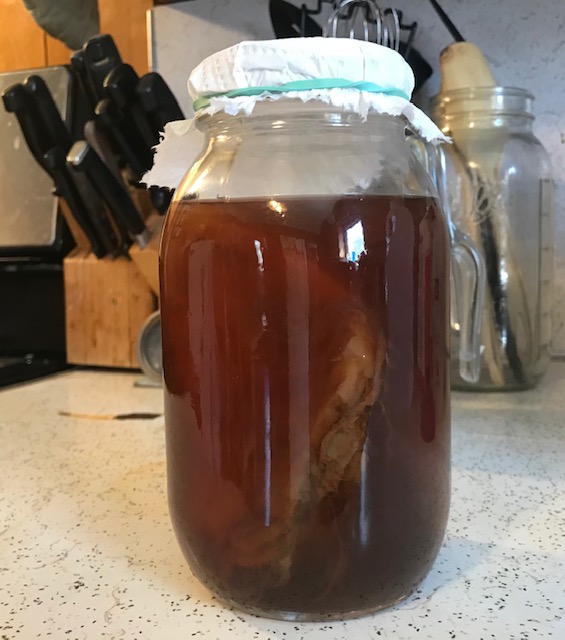 I got myself a new kombucha SCOBY from my friend Eloise, along with some kefir grains. I’ve been relying on expensive probiotic supplements to bridge the gap and, well, it’s kind of dumb to spend good money when I can have the benefit of food nutrients in addition to the good bacteria. I’m trying to be better about making something cultured as part of my weekly food prep routines.
I got myself a new kombucha SCOBY from my friend Eloise, along with some kefir grains. I’ve been relying on expensive probiotic supplements to bridge the gap and, well, it’s kind of dumb to spend good money when I can have the benefit of food nutrients in addition to the good bacteria. I’m trying to be better about making something cultured as part of my weekly food prep routines.
I’ve made saurkraut, yogurt, and rejuvelac successfully in the past. This is my first time doing kombucha and kefir.
A lot of fermentation techniques are super simple to do. Kombucha is one of the easy ones. I really like the explanations and videos given by Angelica over at You Brew Kombucha. I’ll leave the detailed how-to to her. BTW, SCOBY is an acronym for Symbiotic Culture Of Bacteria and Yeast. Rhymes with Adobe.
The basic method is that you make sweet tea, add a bunch of water, tea, “starter tea,”and the SCOBY. Then you wait for nature to take its course.
The yeast eats the sugar and proliferates, producing carbon dioxide. If you brew it long enough in an airtight container, that means it’s going to get fizzy. It’s also going to get more sour the longer it ferments. My spouse used to call kombucha “vinegar pop.”
Of course there are some additional things to do besides the basic process. Ensure you don’t use metal containers or utensils. You must use real sugar. Don’t worry. You won’t be adding it to your diet. It gets eaten by the SCOBY.
You need to ensure you cool down your tea before adding the other ingredients because if the liquid is too hot it might kill the good living microorganisms.
The process is not tricky despite the little rules.It makes plain ‘booch. If you want to add flavoring or lots of fizz, you’ll need to do a second fermentation. No big deal. It’s as simple as adding the tasty stuff and resealing the container.
SCOBYs require some care and feeding. As you make more batches, you’ll have a lot of SCOBY. Put it in a container and cover it with the ‘booch. Keep it out of the sun, at room temperature, covered. You can put the “SCOBY hotel” in the fridge. That will slow the proliferation. It’s totally fine. When you want to make more ‘booch, it will just mean it takes a little longer for the bacteria and yeast to get going.
You can see from the photo that I’ve gotten underway with my kombucha. I’ve also started the kefir. I’ll keep you posted on how it goes.
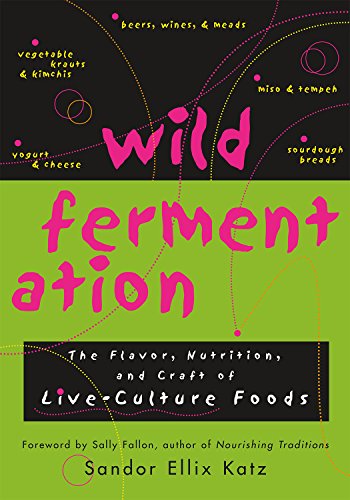 The gut microbiome is integral to health and initial exploratory research is associating with a variety of conditions such as IBS, and depression. At it’s most basic, the bacteria in your gut are a requirement for optimal digestion. Making probiotic rich foods at home is both easy and fun and doesn’t require a big outlay of money.
The gut microbiome is integral to health and initial exploratory research is associating with a variety of conditions such as IBS, and depression. At it’s most basic, the bacteria in your gut are a requirement for optimal digestion. Making probiotic rich foods at home is both easy and fun and doesn’t require a big outlay of money.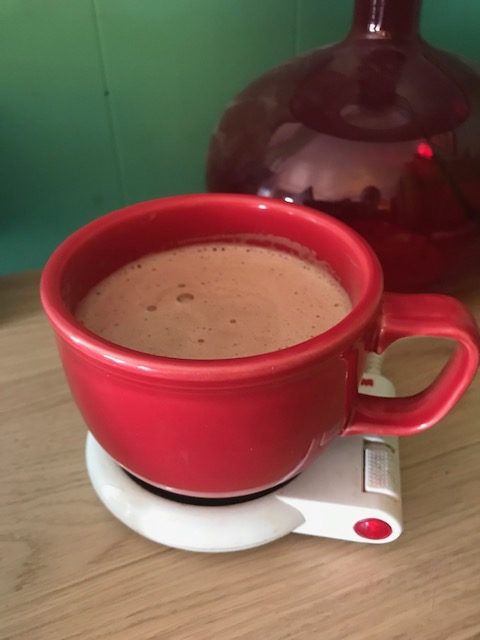 It was chilly here yesterday and I wanted to sip on a warm cozy drink. I find it difficult to get enough protein to support my muscle building goals so I need to supplement my diet. One way I make powders more interesting is to incorporate them into different recipes. Hot chocolate is one of my favorite ways to do it.
It was chilly here yesterday and I wanted to sip on a warm cozy drink. I find it difficult to get enough protein to support my muscle building goals so I need to supplement my diet. One way I make powders more interesting is to incorporate them into different recipes. Hot chocolate is one of my favorite ways to do it.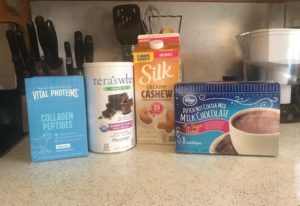 Ingredients
Ingredients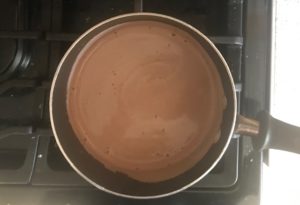 It’s a bit trickier to make the drink come out smoothly when you add protein to it. It can get lumpy because the powders are difficult to blend. It can also separate if you get the liquid too hot. Some sort of chemistry happens when the protein gets to a certain heat and you’re left with gelatinous powder blobs. Stay with the pot, stir it constantly, and drink immediately.
It’s a bit trickier to make the drink come out smoothly when you add protein to it. It can get lumpy because the powders are difficult to blend. It can also separate if you get the liquid too hot. Some sort of chemistry happens when the protein gets to a certain heat and you’re left with gelatinous powder blobs. Stay with the pot, stir it constantly, and drink immediately.